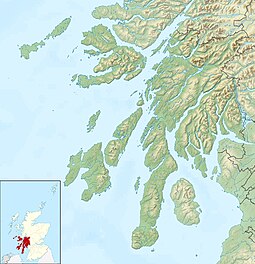| Scottish Gaelic name | Danna |
|---|---|
| Pronunciation | [ˈt̪an̪ˠə] ⓘ |
| Meaning of name | Dane's island[1](Norse origin)[2] |
 An empty farm house on Island of Danna | |
| Location | |
| OS grid reference | NR695785 |
| Coordinates | 55°56′N 5°41′W / 55.94°N 5.69°W |
| Physical geography | |
| Island group | Islay |
| Area | 315 ha (1+1⁄4 sq mi) |
| Area rank | 83 [3] |
| Highest elevation | 54 m (177 ft) |
| Administration | |
| Council area | Argyll and Bute |
| Country | Scotland |
| Sovereign state | United Kingdom |
| Demographics | |
| Population | 1[4] |
| Population rank | 89= [3] |
| Population density | 0.3/km2 (0.78/sq mi)[4][5] |
| References | [5][6] |
The Island of Danna[7] or Danna (Scottish Gaelic: Danna), is an inhabited tidal island in Argyll and Bute.
Geography
[edit]It is connected to the mainland by a stone causeway and is at the southern end of the narrow Tayvallich peninsula, which separates Loch Sween from the Sound of Jura.[8] It is part of the Ulva, Danna and the MacCormaig Isles SSSI.[9] Danna is part of the Knapdale National Scenic Area, one of 40 in Scotland.[10]
Footnotes
[edit]- ^ Michael Eyers (1983). Scottish place names: their meanings explained. Sphere, 1983. ISBN 9780863051609. Retrieved 2 December 2018.
- ^ Mac an Tàilleir, Iain (2003) Ainmean-àite/Placenames. (pdf) Pàrlamaid na h-Alba. Retrieved 26 August 2012.
- ^ a b Area and population ranks: there are c. 300 islands over 20 ha in extent and 93 permanently inhabited islands were listed in the 2011 census.
- ^ a b National Records of Scotland (15 August 2013). "Appendix 2: Population and households on Scotland's Inhabited Islands" (PDF). Statistical Bulletin: 2011 Census: First Results on Population and Household Estimates for Scotland Release 1C (Part Two) (PDF) (Report). SG/2013/126. Retrieved 14 August 2020.
- ^ a b Haswell-Smith, Hamish (2004). The Scottish Islands. Edinburgh: Canongate. ISBN 978-1-84195-454-7.
- ^ Ordnance Survey: Landranger map sheet 61 Jura & Colonsay (Map). Ordnance Survey. 2013. ISBN 9780319229620.
- ^ "Island of Danna". Ordnance Survey. Retrieved 7 February 2019.
- ^ Murray, W.H. (1977) The Companion Guide to the West Highlands of Scotland. London. Collins. Page 89.
- ^ SSSI Designation Archived 28 September 2007 at the Wayback Machine. The nearby Ulva Islands should not be confused with Ulva near Mull.
- ^ "National Scenic Areas". SNH. Retrieved 30 Mar 2011.
Wikimedia Commons has media related to Island of Danna.
55°56′41″N 5°41′27″W / 55.94472°N 5.69083°W

